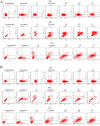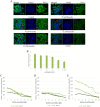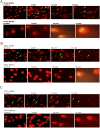A Double-Edged Sword: The Anti-Cancer Effects of Emodin by Inhibiting the Redox-Protective Protein MTH1 and Augmenting ROS in NSCLC
- PMID: 33403025
- PMCID: PMC7778552
- DOI: 10.7150/jca.41160
A Double-Edged Sword: The Anti-Cancer Effects of Emodin by Inhibiting the Redox-Protective Protein MTH1 and Augmenting ROS in NSCLC
Abstract
Background: Reactive oxygen species (ROS), playing a two-fold role in tumorigenesis, are responsible for tumor formation and progression through the induction of genome instability and pro-oncogenic signaling. The same ROS is toxic to cancer cells at higher levels, oxidizing free nucleotide precursors (dNTPs) as well as damaging DNA leading to cell senescence. Research has highlighted the tumor cell-specific expression of a redox-protective phosphatase, MutT homolog 1 (MTH1), that performs the enzymatic conversion of oxidized nucleotides (like 8-oxo-dGTP) to their corresponding monophosphates, up-regulated in numerous cancers, circumventing their misincorporation into the genomic DNA and preventing damage and cell death. Methods: To identify novel natural small molecular inhibitors of MTH1 to be used as cancer therapeutic agents, molecular screening for MTH1 active site binders was performed from natural small molecular libraries. Emodin was identified as a lead compound for MTH1 active site functional inhibition and its action on MTH1 inhibition was validated on non-small cell lung cancer cellular models (NSCLC). Results: Our study provides strong evidence that emodin mediated MTH1 inhibition impaired NSCLC cell growth, inducing senescence. Emodin treatment enhanced the cellular ROS burdens, on one hand, damaged dNTP pools and inhibited MTH1 function on the other. Our work on emodin indicates that ROS is the key driver of cancer cell-specific increased DNA damage and apoptosis upon MTH1 inhibition. Consequently, we observed a time-dependent increase in NSCL cancer cell susceptibility to oxidative stress with emodin treatment. Conclusions: Based on our data, the anti-cancer effects of emodin as an MTH1 inhibitor have clinical potential as a single agent capable of functioning as a ROS inducer and simultaneous blocker of dNTP pool sanitation in the treatment of NSCL cancers. Collectively, our results have identified for the first time that the potential molecular mechanism of emodin function, increasing DNA damage and apoptosis in cancer cells, is via MTH1 inhibition.
Keywords: Emodin; MTH-1; NCSLC; NUDT-1; ROS; lung cancer; oxidative DNA damage.
© The author(s).
Conflict of interest statement
Competing Interests: The authors have declared that no competing interest exists.
Figures


























Similar articles
-
TH588, an MTH1 inhibitor, enhances phenethyl isothiocyanate-induced growth inhibition in pancreatic cancer cells.Oncol Lett. 2018 Mar;15(3):3240-3244. doi: 10.3892/ol.2017.7713. Epub 2017 Dec 29. Oncol Lett. 2018. PMID: 29435064 Free PMC article.
-
MTH1 deficiency selectively increases non-cytotoxic oxidative DNA damage in lung cancer cells: more bad news than good?BMC Cancer. 2018 Apr 16;18(1):423. doi: 10.1186/s12885-018-4332-7. BMC Cancer. 2018. PMID: 29661172 Free PMC article.
-
MutT Homolog 1 (MTH1) maintains multiple KRAS-driven pro-malignant pathways.Oncogene. 2015 May 14;34(20):2586-96. doi: 10.1038/onc.2014.195. Epub 2014 Jul 14. Oncogene. 2015. PMID: 25023700 Free PMC article.
-
Mechanisms of MTH1 inhibition-induced DNA strand breaks: The slippery slope from the oxidized nucleotide pool to genotoxic damage.DNA Repair (Amst). 2019 May;77:18-26. doi: 10.1016/j.dnarep.2019.03.001. Epub 2019 Mar 2. DNA Repair (Amst). 2019. PMID: 30852368 Free PMC article. Review.
-
MTH1 as a Chemotherapeutic Target: The Elephant in the Room.Cancers (Basel). 2017 May 8;9(5):47. doi: 10.3390/cancers9050047. Cancers (Basel). 2017. PMID: 28481306 Free PMC article. Review.
Cited by
-
Is Emodin with Anticancer Effects Completely Innocent? Two Sides of the Coin.Cancers (Basel). 2021 May 31;13(11):2733. doi: 10.3390/cancers13112733. Cancers (Basel). 2021. PMID: 34073059 Free PMC article. Review.
-
Activation of DNA Damage Tolerance Pathways May Improve Immunotherapy of Mesothelioma.Cancers (Basel). 2021 Jun 27;13(13):3211. doi: 10.3390/cancers13133211. Cancers (Basel). 2021. PMID: 34199066 Free PMC article.
-
Role of emodin to prevent gastrointestinal cancers: recent trends and future prospective.Discov Oncol. 2025 Apr 5;16(1):468. doi: 10.1007/s12672-025-02240-9. Discov Oncol. 2025. PMID: 40186678 Free PMC article. Review.
-
Targeting MutT Homolog 1 (MTH1) for Breast Cancer Suppression by Using a Novel MTH1 Inhibitor MA-24 with Tumor-Selective Toxicity.Pharmaceuticals (Basel). 2024 Feb 23;17(3):291. doi: 10.3390/ph17030291. Pharmaceuticals (Basel). 2024. PMID: 38543077 Free PMC article.
-
Natural anti-cancer products: insights from herbal medicine.Chin Med. 2025 Jun 9;20(1):82. doi: 10.1186/s13020-025-01124-y. Chin Med. 2025. PMID: 40490812 Free PMC article. Review.
References
-
- WHO. Cancer. 2018.
-
- Coleman JF. Robbins and Cotran's Pathologic Basis of Disease, 8th Edition. The American Journal of Surgical Pathology. 2010;34:132.
-
- Siegel RL, Miller KD, Jemal A. Cancer statistics, 2015. CA: a cancer journal for clinicians. 2015;65:5–29. - PubMed
-
- Ziech D, Franco R, Pappa A, Panayiotidis MI. Reactive oxygen species (ROS)-induced genetic and epigenetic alterations in human carcinogenesis. Mutation research. 2011;711:167–73. - PubMed
-
- Ilonen IK, Räsänen JV, Sihvo EI, Knuuttila A, Salmenkivi KM, Ahotupa MO. et al. Oxidative stress in non-small cell lung cancer: Role of nicotinamide adenine dinucleotide phosphate oxidase and glutathione. Acta Oncologica. 2009;48:1054–61. - PubMed
LinkOut - more resources
Full Text Sources
Other Literature Sources

